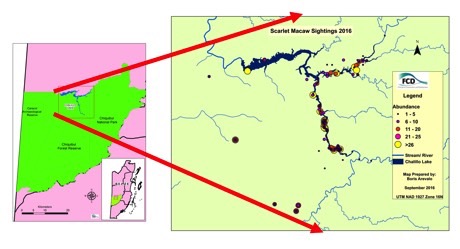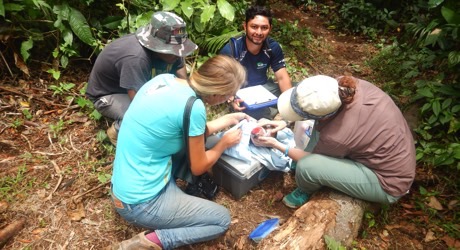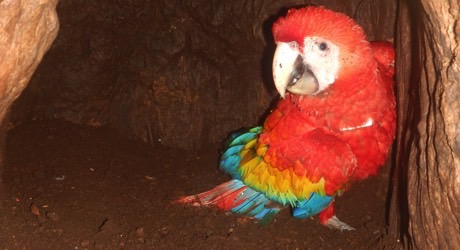In 2020, a total of 25 macaws returned to the wild
as a result of the of the improved biomonitoring conducted by FCD. Of these 25
chicks, 18 fledged from their natural nest while 7 were released through the
in-situ program which was re-initiated that year. In 2021, 24 macaws fledged
successfully to the wild and of these, 17 were from their natural nests while 4
from the in-situ program. Additionally, a fully functional field base camp was
constructed and allowed for
FCD to safely host volunteers who participated
through the Citizen Science Program. In 2020, FCD hosted 20 volunteers while in
2021, we hosted 21 volunteers. 6 FCD staff received training in Customer
Service and 4 field staff (100%) also received training in Wildlife Care and
Wildlife Protection Act.
This project has provided FCD
with the capacity to institute an innovative Citizen Science Program and has
enabled our staff to launch a Save Our Scarlets (SoS) Tour as a signature
experience. Full endorsement is pending from the Ministry of Tourism and the
Ministry of Sustainable Development
How was the community involved?
FCD’s Biodiversity Research
and Monitoring Team were involved throughout the project. They were the team
that conducted the field activities related to the monitoring and protection of
the scarlet macaw.
The local volunteers were also
involved as they were provided the opportunity to participate in the program as
Citizen Scientists. These volunteers were from all over Belize and included
local tour guides, university students and local conservation and adventure
enthusiasts. At the end of their voluntary experience, the individuals have
filled an evaluation form and 100% of volunteers rate the experience at 10 out
of 10.
One of the volunteers, Galento Galvez, who participated in 2021 said, “I
would recommend this program to anyone who wants to experience the gifts that
Belize has to offer. It’s a very insightful program that imbeds the necessity
for conservation and protection in Belize!”
What’s Next?
For FCD, the Scarlet Macaw
Conservation Program is a long-term program. In Belize, the scarlet macaws are
still endangered and, therefore FCD’s ongoing efforts to safeguard this species
is multi-faceted and include protection of their natural habitat, deterring the
poaching and trade and increasing awareness. The current management plan of the
Chiquibul National Park also identifies the scarlet macaw as a conservation
target.
A binational Illegal Wildlife Trafficking Taskforce
has been created to address the threat to the scarlet macaw and other wildlife
so multiple players are involved in the discussion and actions regarding this
species. The Citizen Science Program has also been instituted as part of the
Scarlet Macaw Conservation Program.
The scarlet macaw breeding
habitat has remained as an exclusive area for research and monitoring. However,
it does have a high tourism potential. FCD does require to establish a solid
presence and program that is conducive towards generating a financial stream
for macaw conservation yet ensuring that the population is safeguarded.
Capacity building and exposure to on how to do this will be important as we
progress into a tourism development scheme.
Project Background
Of the nine parrot species in Belize, the scarlet macaw is not only the most colourful but also the most endangered. The bright red, blue and yellow feathered bird is a spectacular sight of the neo-tropics and an emblematic species for Belize.
In the Chiquibul Forest this bird has been thriving over the years and despite the construction of a dam, which threatened to extirpate the breeding population over a decade ago, this parrot has survived the flooded habitat and is slowly recovering. With no more than 125 pairs of scarlet macaws left in Belize the need to institute medium and long-term interventions to protect this species is critical, not only from poachers but from any future unregulated tourism activity.
Currently their main breeding habitat in the Chalillo dam is not a tourism hot spot, however the industry has identified it as a ‘must see’ destination. Friends for Conservation and Development (FCD) cannot possibly stop this development, but instead plan to have an assertive presence to conduct biological monitoring; protect nesting sites and chicks at risk of being poached in the wild, upgrade facilities for in-situ hand rearing of chicks and regulate the flow of visitors in the area.

Project Overview
With ATCF funding, the FCD is seeking to construct a field base, upgrade their research headquarters, equip the field teams, promote citizen science participation and train field technicians around the Chalillo Lake area.
The field base will be located at a strategic anchor point for FCD rangers, researchers, volunteers and other visitors. Upgrade of the research headquarters will occur at Las Cuevas Research Station which will support a presence of staff involved in hand rearing of scarlet macaws. Equipment would include headlamps, GPs, binoculars, cameras and field uniforms. Field personnel will be trained on rules and regulations, visitor satisfaction and wildlife care. In addition, funds will be used to develop guidelines and materials for volunteers in support of the citizen science program.
The specific anticipated outputs of the project are:
- A field base is operational at the Chalillo Lake.
- FCD field staff accommodated seven months at the field base.
- FCD research facilities are upgraded to support in-situ conservation efforts.
- 100% of field staff understand the laws and rules that protect macaws.
- Visitor Impact monitoring guidelines approved and followed.
The overall result will be measured by the number macaws that make it successfully to the wild.

What's Covered in Project Cost
- Facilities and equipment – $3,750
- Training – $1,000
- T-shirt production – $250
- Construction of biomonitoring base camp – $10,000
- Upgrade FCD research facilities – $5,000
Partners and Community Involvement
Apart from the FCD field staff, the Forest Department is the key authority and the primary partner in permitting us to conduct biomonitoring and any in-situ conservation efforts. Personnel from the Belize Wildlife and Referral Clinic are also important partners primarily in providing the necessary health checks on macaws being monitored.
Volunteers including Cayo Tour Guide Association members and students from the University of Belize will also play an important role in helping support the biomonitoring. The Belize Electric Company Limited on the other hand will play a key role in proving counterpart funds as well as facilitating our mobilization into the Chalillo Lake.

Part of a Larger Strategy
This project follows the guidelines presented on the document titled, “Bi-national Collaboration to Eradicate Wildlife Trafficking in Belize and Guatemala: A Strategy for the Chiquibul Forest.” The Strategy notes that, “Poaching is the major threat to the survival of the species in Belize, reaching its peak in 2011, where almost 88.9% of all monitored nests were lost due to poaching. With the observed poaching rate, conservation and management strategies were employed managing to greatly reduce poaching.
With intensive protection efforts initiated in 2012 by FCD and Scarlet Six Biomonitoring Team, poaching ranged between 27 and 33.3% of monitored nests from 2012 - 2014, losing 30 to 38% of chicks hatched per the season, while 0% of monitored Scarlet Macaw chicks have been poached from 2015 to 2018 due to continuous bio-monitoring efforts. However, it is believed that other nesting sites are still undiscovered especially on upland areas and riparian flats of the Ceibo Chico and Ceibo Grande Rivers in southern Chiquibul.”